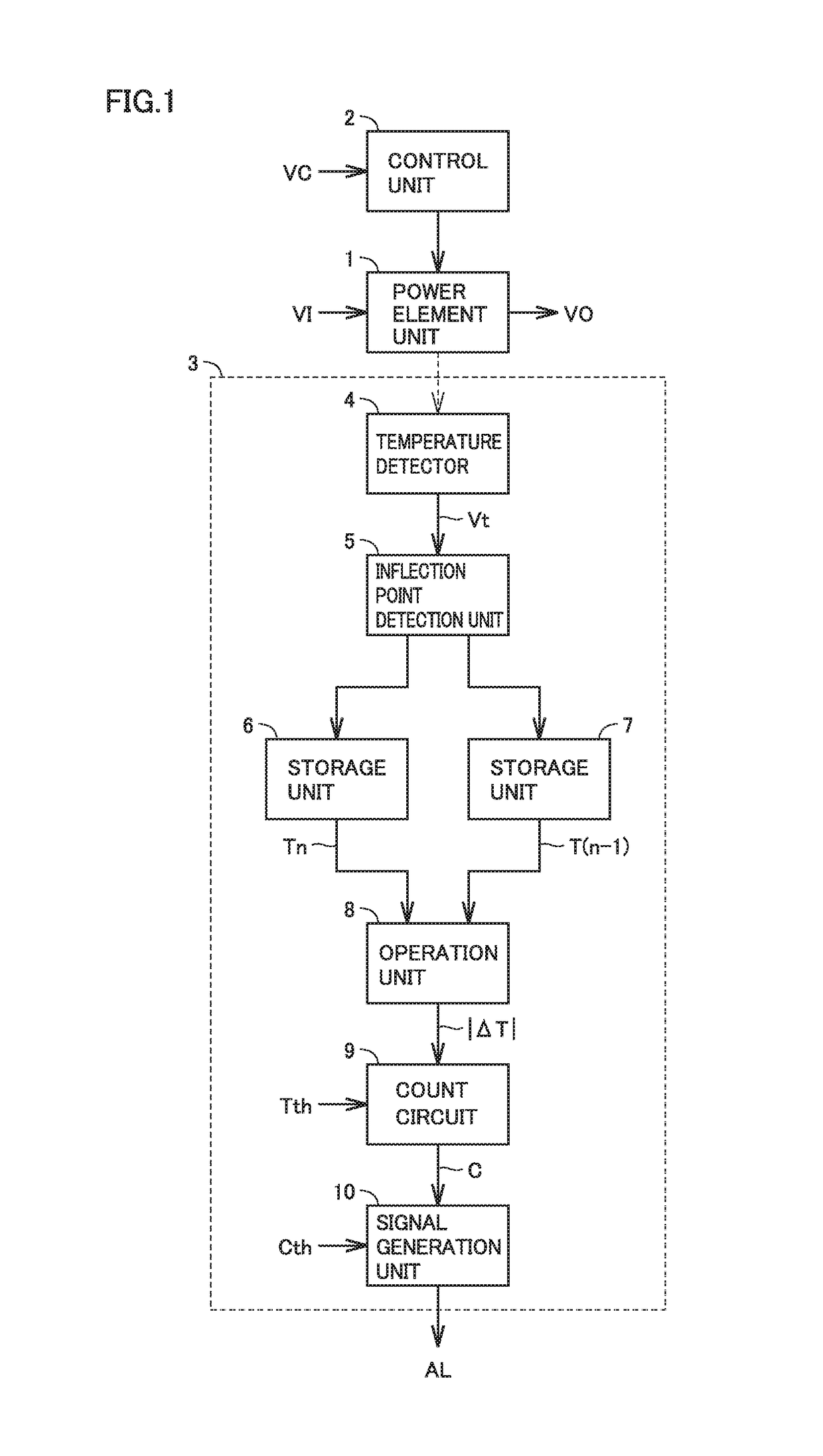Life Estimation Circuit and Semiconductor Device Made Using the Same
a technology of life estimation and circuit, which is applied in the direction of individual semiconductor device testing, semiconductor operation lifetime testing, transistors, etc., can solve the problem of inability to accurately estimate and achieve the effect of accurate detection and accurate estimation of the life of power elements
- Summary
- Abstract
- Description
- Claims
- Application Information
AI Technical Summary
Benefits of technology
Problems solved by technology
Method used
Image
Examples
first embodiment
[0022]FIG. 1 is a block diagram showing the configuration of a power module according to a first embodiment of the present invention. In FIG. 1, this power module includes a power element unit 1, a control unit 2, and a life estimation circuit 3.
[0023]Power element unit 1 includes a plurality of power elements, is controlled by control unit 2, and converts a direct-current (DC) voltage VDC into an alternating-current (AC) voltage VAC, for example. The power elements are IGBTs (Insulated Gate Bipolar Transistors), MOSFETs, bipolar transistors, diodes or the like.
[0024]Control unit 2 coverts DC voltage VDC into sinusoidal AC voltage VAC by turning each of the plurality of power elements of power element unit 1 on / off based on, for example, a sinusoidally varying voltage command value VC. When a current is passed through the power element, loss (namely, heat) occurs in the power element, whereby the temperature of the power element increases. When the current flowing through the power ...
second embodiment
[0038]FIG. 2 is a block diagram showing the configuration of a power module according to a second embodiment of the present invention, which is compared with FIG. 1. With reference to FIG. 2, this power module is different from the power module shown in FIG. 1 in that count circuit 9 and signal generation unit 10 have been replaced with a count circuit 15 and a signal generation unit 16, respectively.
[0039]Count circuit 15 compares first to third threshold temperatures Tth1 to Tth3 with absolute value |ΔT| of the temperature difference determined by operation unit 8, and determines which one of first to third temperature variations ΔT1 to ΔT3 has occurred based on results of the comparisons. Tth1>Tth2>Tth3 holds. When Tth11 has occurred. When Tth21 is satisfied, it is determined that second temperature variation ΔT2 has occurred. When Tth32 is satisfied, it is determined that third temperature variation ΔT3 has occurred.
[0040]Count circuit 15 increments (+1) a first count value C1 w...
third embodiment
[0055]FIG. 4 is a block diagram showing the configuration of a power module according to a third embodiment, which is compared with FIG. 1. With reference to FIG. 4, this power module is different from the power module shown in FIG. 1 in that signal generation unit 10 has been replaced with a signal generation unit 20. Signal generation unit 20 outputs a digital signal DO indicating a difference Cth−C between threshold number of times Cth and count value C. Digital signal DO serves as a signal indicating an allowable number of times that a temperature variation occurs, that is, the remaining life of power element unit 1.
[0056]In this third embodiment, maintenance of the system, replacement of the power module and the like can be performed in a planned manner based on signal DO indicating the remaining life of power element unit 1.
[0057]Furthermore, since digital signal DO indicating the remaining life of power element unit 1 is output, the circuit size can be reduced, the number of ...
PUM
 Login to View More
Login to View More Abstract
Description
Claims
Application Information
 Login to View More
Login to View More - R&D
- Intellectual Property
- Life Sciences
- Materials
- Tech Scout
- Unparalleled Data Quality
- Higher Quality Content
- 60% Fewer Hallucinations
Browse by: Latest US Patents, China's latest patents, Technical Efficacy Thesaurus, Application Domain, Technology Topic, Popular Technical Reports.
© 2025 PatSnap. All rights reserved.Legal|Privacy policy|Modern Slavery Act Transparency Statement|Sitemap|About US| Contact US: help@patsnap.com



